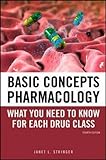Basic concepts in pharmacology
Material type: TextPublication details: New York McGraw-Hill Medical 2011Edition: 4th edDescription: 240 p. xiii, ill.; 10cmISBN:
TextPublication details: New York McGraw-Hill Medical 2011Edition: 4th edDescription: 240 p. xiii, ill.; 10cmISBN: - 9780071741040
- 0071741046
- RM301.14 .S77 2011
| Item type | Current library | Collection | Call number | Copy number | Status | Date due | Barcode | |
|---|---|---|---|---|---|---|---|---|
 Books
Books
|
College of Pharmacy Library | Clinical Pharmacy and Public Health | RM301.14 .S77 2011 (Browse shelf(Opens below)) | 1 | Available | 19-206136 |
Browsing College of Pharmacy Library shelves, Collection: Clinical Pharmacy and Public Health Close shelf browser (Hides shelf browser)

|

|

|

|

|

|

|
||
| RM300 .W54 2018 The philosophy of drugs | RM 301 .D62 2013 Drugs in use. Case studies for pharmacist and prescribers | RM 301 .D62 2013 Drugs in use. Case studies for pharmacist and prescribers | RM301.14 .S77 2011 Basic concepts in pharmacology | RM301.25.G54 2017 Pharmacological experimentation | RM 301.28 .B37 2007 Basic and clinical pharmacology | RM 301.28 .B37 2007 Basic and clinical pharmacology |
index.
Machine generated contents note: <b>Chapter 1.</b> Where to Start; <b>Part I: General Principles</b>; <b>Chapter 2.</b> Receptor Theory; <b>Chapter 3.</b> Absorption, Distribution and Clearance; <b>Chapter 4.</b> Pharmacokinetics; <b>Chapter 5.</b> Drug Metabolism and Renal Elimination; <b>Part II: Drugs That Affect the Autonomic Nervous System</b>; <b>Chapter 6.</b> Review of the Autonomic Nervous System; <b>Chapter 7.</b> Cholinergic Agonists; <b>Chapter 8.</b> Cholinergic Antagonists; <b>Chapter 9.</b> Adrenergic Agonists; <b>Chapter 10.</b> Adrenergic Antagonists; <b>Part III: Drugs That Affect the Cardiovascular System</b>; <b>Chapter 11.</b> Antihypertensive Drugs; <b>Chapter 12.</b> Drugs used ischemic heart disease and congestive heart failure <b>Chapter 13.</b> Antiarrrhytmic Drugs; <b>Chapter 14.</b> Drugs that Affect Blood; <b>Chapter 15.</b> Lipid-Lowering Drugs; <b>Part IV: Drugs Acting on the Central Nervous System</b>; <b>Chapter 16.</b> Drugs used in dementia 17.</b>Anxiolytic and Hypnotic Drugs; <b>Chapter 18.</b> Drugs Used in Mood Disorders; <b>Chapter 19.</b> Antipsychotics or Neuroleptics; <b>Chapter 20.</b> Drugs Used in Parkinson's Disease; <b>Chapter 21.</b> Antiepileptic Drugs; <b>Chapter 22 </b> Narcotics (opiates); <b>Chapter 23.</b> General Anesthetics; <b>Chapter 24.</b> Local Anesthetics; Part V: Chemotherapeutic agents<b>;<b>Chapter 25.</b> Introduction to Chemotherapy; <b>Chapter 26.</b> Inhibitors of Cell Wall Synthesis; <b>Chapter 27.</b> Proteins Synthesis Inhibitors; <b>Chapter 28.</b> Folate Anatgonists; <b>Chapter 29.</b> Quinolones and Urinary Tract Antiseptics; <b>Chapter 30.</b> Drugs Used in Tuberculosis and Leprosy; <b>Chapter 31.</b> Antifungal Drugs; <b>Chapter 32.</b> Anthelmintic Drugs; <b>Chapter 33.</b> Antiviral Drugs; <b>Chapter 34.</b> Antiprotozoal Drugs; <b>Chapter 35.</b> Anticancer Drugs; <b>Part VI: Drugs that Affect the Endocrine System</b>; <b>Chapter 36.</b> Andrenocortical Hormones; <b>Chapter 37.</b> Sex Steroids; <b>Chapter 38.</b> Thyroid and Parathyroid Drugs<b>Chapter 39.</b> Insulin, Glucagon and Oral Hypoglycemic Drugs; <b>Part VII: Miscellaneous Drugs</b>; <b>Chapter 40.</b> Histamine and Antihistamines; <b>Chapter 41.</b> Respiratory Drugs; <b>Chapter 42.</b> Drugs that Affect the GI Tract; <b>Chapter 43.</b> Nonnarcotic Analgesics and Anti-Inflammatory Drugs; <b>Chapter 44.</b> Immunosuppressives; <b>Chapter 45.</b> Drugs Used in Osteoporosis; <b>Chapter 46.</b> Toxicology and poisoning.
"A proven method for learning the most difficult-to-understand concepts in pharmacology. Great for USMLE review! Basic Concepts in Pharmacology provides students with a complete framework for studying the fundamental principles of drug actions. This unique study system helps students set priorities, minimize memorization, and reduce stress.The book includes study techniques not found in any other book and details exactly what student need to know about each drug class to pass the course and the USMLE. Features: Simplifies the learning process by presenting drugs by class. Reinforces essential concepts and definitions. Written in a conversational engaging style. Organizes and condenses must-know drug information. NEW larger trim size. Numerous summary tables, illustrations, and boxes encapsulate key concepts. The content you need to understand essential pharmacology material:"--Provided by publisher.
English
There are no comments on this title.
© 2024 ABUAD. All Rights Reserved
Support: library@abuad.edu.ng
ABUAD OPAC is powered by Koha
Installed and customised by Libtech Resource and Services

